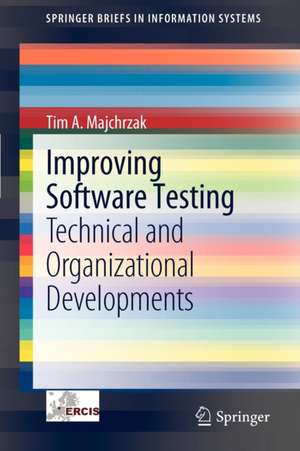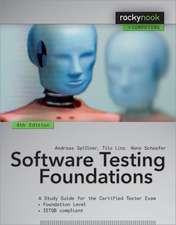Improving Software Testing: Technical and Organizational Developments: SpringerBriefs in Information Systems
Autor Tim A. Majchrzaken Limba Engleză Paperback – 4 feb 2012
Preț: 347.96 lei
Nou
Puncte Express: 522
Preț estimativ în valută:
66.58€ • 69.66$ • 55.31£
66.58€ • 69.66$ • 55.31£
Carte tipărită la comandă
Livrare economică 02-16 aprilie
Preluare comenzi: 021 569.72.76
Specificații
ISBN-13: 9783642274633
ISBN-10: 3642274633
Pagini: 180
Ilustrații: XVIII, 160 p. 17 illus.
Dimensiuni: 155 x 235 x 15 mm
Greutate: 0.26 kg
Ediția:2012
Editura: Springer Berlin, Heidelberg
Colecția Springer
Seria SpringerBriefs in Information Systems
Locul publicării:Berlin, Heidelberg, Germany
ISBN-10: 3642274633
Pagini: 180
Ilustrații: XVIII, 160 p. 17 illus.
Dimensiuni: 155 x 235 x 15 mm
Greutate: 0.26 kg
Ediția:2012
Editura: Springer Berlin, Heidelberg
Colecția Springer
Seria SpringerBriefs in Information Systems
Locul publicării:Berlin, Heidelberg, Germany
Public țintă
ResearchCuprins
Foreword.- 1. Introduction.- 2. Software Testing.- 3. Research Design.- 4. Technical Aspects: Muggl.- 5. Organizational Aspects: The IHK Project.- 6. Testing and E-Assesment.- 7. Conclusion.- 8. Future Work.- References.- Glossary.- Index.
Textul de pe ultima copertă
Software is continuously increasing in complexity. Paradigmatic shifts and new development frameworks make it easier to implement software – but not to test it. Software testing remains to be a topic with many open questions with regard to both technical low-level aspects and to the organizational embedding of testing. However, a desired level of software quality cannot be achieved by either choosing a technical procedure or by optimizing testing processes. In fact, it requires a holistic approach.This Brief summarizes the current knowledge of software testing and introduces three current research approaches. The base of knowledge is presented comprehensively in scope but concise in length; thereby the volume can be used as a reference. Research is highlighted from different points of view. Firstly, progress on developing a tool for automated test case generation (TCG) based on a program’s structure is introduced. Secondly, results from a project with industry partners on testing best practices are highlighted. Thirdly, embedding testing into e-assessment of programming exercises is described.
Caracteristici
Cutting edge research Brief yet comprehensive introduction to software testing Rather easy to read Includes supplementary material: sn.pub/extras



























